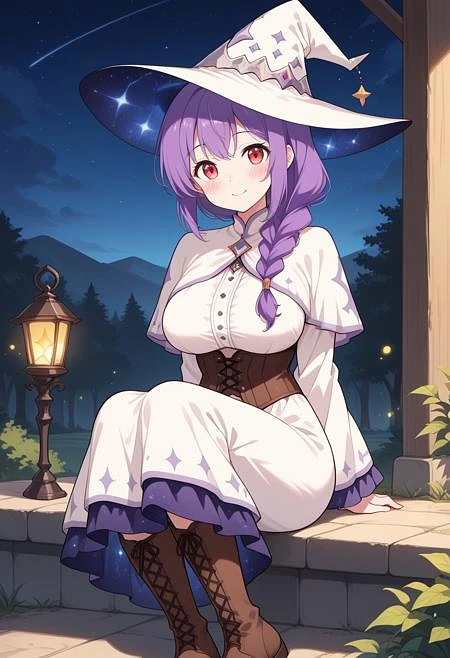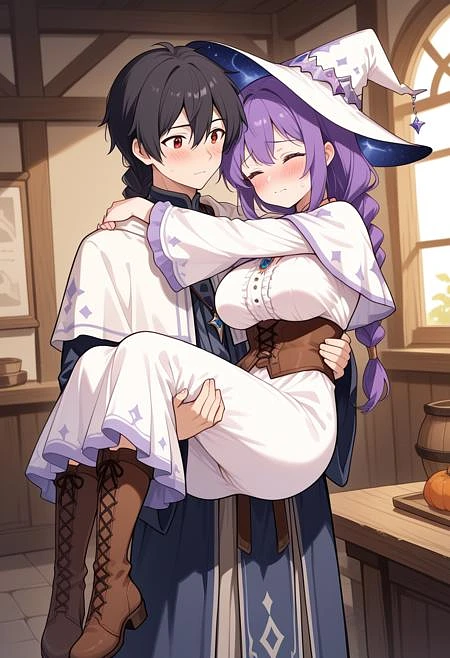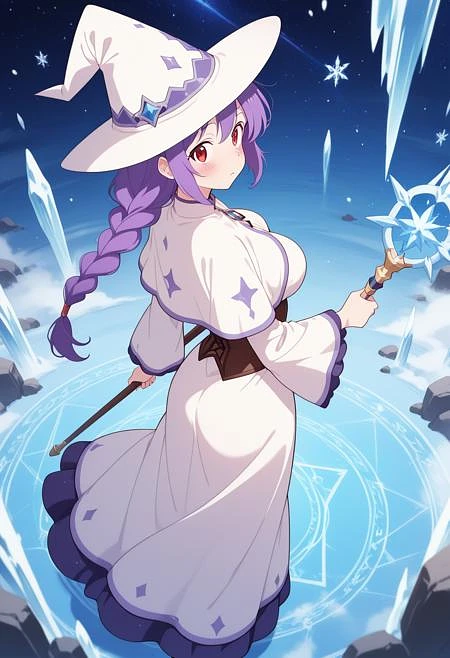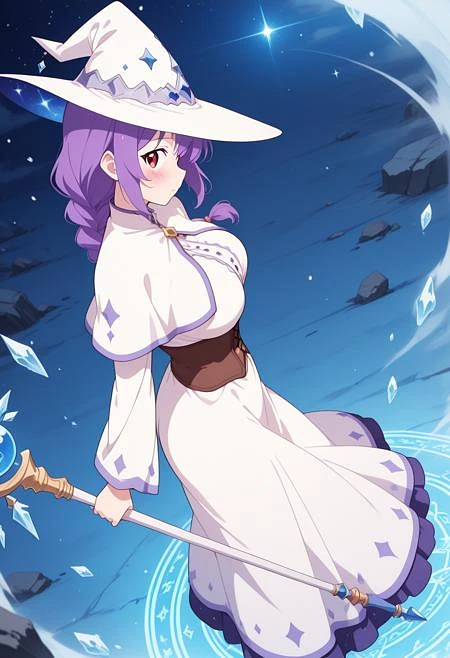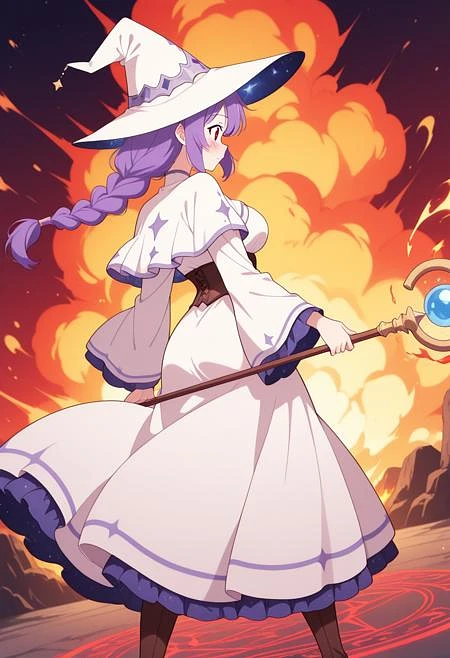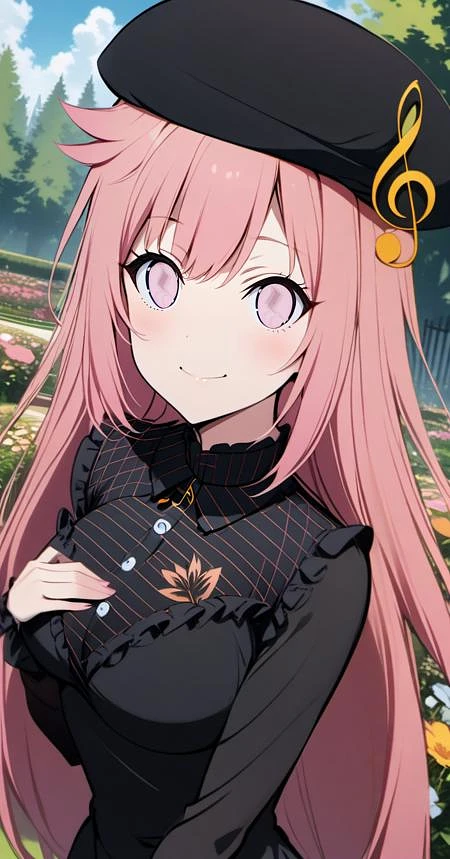Melita:
Doing some simple basic testing with a character turnaround. Melita's design is really simple so I'm not exactly looking for high consistency with her and wanted to have some sort of baseline for loopback testing. Unfortunately, I wasn't very successful so it's not really worthwhile writing and article for. I'll probably need to design a character with more complex details later for more stress testing. It seems for Illustrious knowing the proper prompts/artist keywords seem to help with the posing. The dataset is only a limited turnaround so the posing is very stiff. The anytest CN can help with adding dimensionality to the character which I think is only possible as her design is really straightforward.
Prisca
A complex character design. Images are very cherrypicked on the basis of the outfit but the LoRA performs very well in terms of inpainting. More overtrained compared to the other LoRAs due to loopback usage.
Elris
A rather simple character design this time to test out a couple of things regarding accessory training, and clustered objects along with experimenting with loopback.
3/4/24 Update:
Blind Test with SDXL training. I'll write an article about this later. Read 'About this Model' for more details.
Kie recommended weight:1
I am probably going to need to change the title of the page now since I am using txt2img ControlNets to augment the dataset for style. (I did use a LoRA to loopback but I used weight of .1~.2 and outd to weaken the effect. I did another round without the LoRA and the difference wasn't very noticable). Read below if you want see the specifics of the augmentation.
Enna LoRA focuses on a simpler design to see what mistakes in the turnaround make an impact on the LoRA design
About
This is a place where I keep my tests with single image OC LoRAs. The goal is to try and create a consistent character LoRA with a minimum amount of effort. If you're willing to spend time, you can create a consistent character in this tutorial here (not mine). Keep in mind that these experiments are more of a learning effort rather than producing an accurate LoRA. Due to the limited dataset, these LoRA are highly likely overfit in weird scenarios that I haven't tested yet. I'll probably write an article about the process in the future.
Articles on Workflow
Images are of-course cherry picked with adetailer and hi-res fix with (AnimeSharp4x\UltraSharp4x) at 0.2 ~ 0.5 denoising strengths.
Isabella's original image is the second image in V1. (Base prompt might be useful)
Usage
Recommended Weight for V4: (0.5~0.8) Block Weight can help but isn't completely necessary.
Recommended Weight: 0.6 ~ 0.8 + (LoRA Block Weight with OUTD preset recommended; For version 3, the block weight extension is highly recommended).
For Enna: Recommended Weight: 0.8 ~ 1 (Lower if encounter concept bleeding)
Use terms such as: flat_chest,petite to get character proportions correct.
You can get away with 1 weight with the block weight extension but will need to lower the weight if you want do custom outfits. Requires long prompts that describe that character and the environment to work well.
It should work well enough with anime-based models, I haven't tried anything realistic or semi-realistic. Probably best used with an inpainting workflow.
Problems
Inconsistency with coloring and outfit
facial expression is overfit
Hairline is occasionally flipped
V2 is probably better than V3; I ran into a roadblock but decided to publish my results for now
Training
V1
1 Full body shot +1 crop image of face (same image)
Trained on NovelAi
V2
Reused dataset from V1
Added upperbody,lowerbody, and leggings crop
lowered repeats
more captioning
V3
removed flip augmentation
reused data set from v1
added 3/4 images of the head and skirt, boots to neck,close-up of bangs
more captioning
Others
I likely hit a wall with Isabella so I might not be able to improve the LoRA any further. There are a few more things I could try with kohyaSS trainer but I'm not expecting much. The main limitation is that the base image isn't very high quality and has image artifacts on zoom up.
V4
reused data from v3
moved regularization over into the main dataset and added trigger words for style
-
added style images using txt2img with canny and lineart using regional prompter to augment the dataset for style, tagged as 'alternativecostume'
selected images with closest colors
added style and outfit triggerwords
n tokens increased to 4
removed block weight during training
Enna
V1
Based on a character turnaround
Uses same concepts from V4
V1.1
minor update with more captioning and lower training rates by 1/10th
V2
Added full turnaround of swimsuit and underwear
Popularity
Info
Version Elrisv2_loopback: 2 Files
About this version: Elrisv2_loopback
This is a rather simple character to only test how LoRA training affects headwear, neckwear and clustered objects.
Recommended Strength:
0.8 ~ 1 for general usage
0.5 or use fewer keywords if you want to change the bikini type
Dataset:
Original base image at 4096 x 11040 resolution
image cropped into multiple smaller images for more detail
used faceless/face censor augmentation
Style Augmentation for reducing style bleed
Loopback training to help with outfit swapping
Observations:
Necklace and number pattern design was earliest than expected
Getting the flower next to the frills was harder than initially expected and doesn't generate all of the time
Face trains quickly
Notable Changes
Trained with prodigy optimizer
Doesn't require a trigger word
Trigger word for Elris is included along with captions for numberbikini and alternativeoutfit exist. These keywords don't seem to have much of an impact but numberbikini can help with the success rate of the flower appearing
Loopback images included
This is mostly to help with outfit removability. Added multiple outfits + nude images
Requires specific negatives such as head_out_of_frame, faceless, censored, identity_censor,face_censor in negative prompt
Issues/Difficulty:
Posing is stiff and/or requires prompt emphasis
Having separate wings is difficult
LoRA likes to place a lot of extra moles
Style Bleeding but can be mitigated with artist keywords
Face size is overtrained
11 Versions
Go ahead and upload yours!
